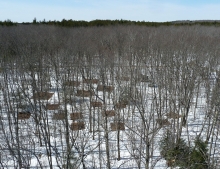You are here
Study: Diverse Soil Community Key to Climate Protection

As soil microorganisms decompose plant and animal material, globally, they release 10 times more greenhouse gases to the atmosphere than humans do. A warming climate and increased nitrogen pollution accelerate this process, triggering the release of even more greenhouse gases. New results from the Forest's long-term soil warming experiment, published last week in the Proceedings of the National Academy of Sciences, reveals how a diverse soil community plays a crucial role in regulating climate change, because larger soil invertebrates - like pillbugs - feed on the specific class of microbes that are releasing most of the carbon.
The research was an international collaboration including Harvard Forest and University of New Hampshire scientists Serita Frey and Linda van Diepen.
- Read news stories in Pacific Standard, Al Jazeera America, and AAAS Science News.
- Read the original scientific paper in PNAS: "Biotic interactions mediate soil microbial feedbacks to climate change."
- Learn more about soil carbon and nitrogen dynamics research at the Forest.
(Photo of HF's long-term soil warming research plots by Audrey Barker Plotkin.)

